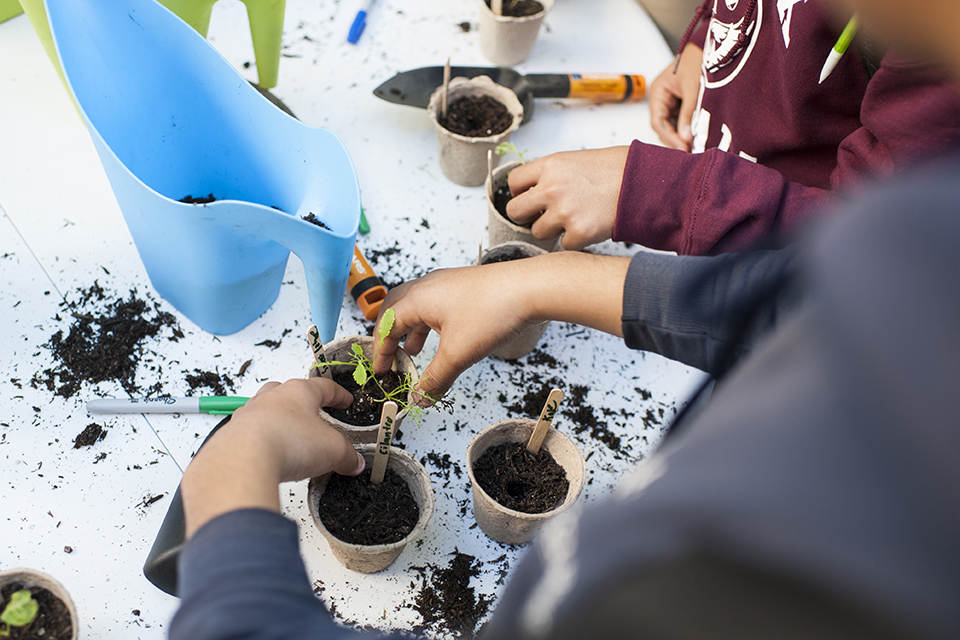BUILD PODER Continues to Fight Inequity at 2017 Youth Empowerment Day
“There are five times more alcohol advertisements in Latino neighborhoods than in white neighborhoods. I think you should know that,” said Johnny, an eighth grader who shared his poster presentation with a crowd of 150 during the inaugural BUILD PODER Youth Empowerment Day at California State University, Northridge.
Johnny was one of 120 eighth graders at Nueva Esperanza Charter Academy in San Fernando who received in-class science lessons from BUILD PODER undergraduate scholars, as part of their “K-12 STEM Outreach” capstone course. BUILD PODER seniors give back to the community through the course, teaching concepts of science, critical race theory and health equity.
“The BUILD PODER program is in the unique position to expose my students to CSUN students who look like them and often come from the same background and neighborhoods,” said Nueva Esperanza Principal Fidel Ramirez. “This is extremely important when we are trying to promote the importance of research, social justice and beginning to cultivate the next generation of scientists!”
BUILD PODER is the university’s research training program that is supported by a $22-million, five-year grant from the National Institutes of Health (NIH) — the largest grant in CSUN’s history. In its third year, the program has grown to 150 students for 2017-18, with more than 100 faculty members involved as research mentors. BUILD PODER stands for Building Infrastructure to Diversity (BUILD) and Promoting Opportunities for Diversity in Education and Research (PODER). The program aims to increase diversity in biomedical research fields and prepare participants for Ph.D. programs.
Youth Empowerment Day, which took place Dec. 1 at the CSUN University Student Union’s Grand Salon, provided an opportunity for the Nueva Esperanza students to visit the college campus, finish their last science lesson, learn about CSUN students’ research and present what they learned over the semester to their peers. The eighth graders participated in a variety of activities and experiments on topics such as nutrition and food sourcing, sugar and diabetes, kidney health, and alcoholism.
The K-12 course aims to reinforce community empowerment and promote health equity by using BUILD PODER students as role models, said CSUN psychology professor Carrie Saetermoe, one of the principal investigators of the BUILD PODER grant.
“Students at Nueva Esperanza are mentored by and learn from students who come from similar backgrounds and who have achieved a great deal,” Saetermoe said.
Saetermoe and CSUN psychology professor Gabriela Chavira, co-principal investigator of the grant, designed the program based on critical race theory, which challenges dominant ideology by asserting that racism is systemic in American life. Critical race theory takes an interdisciplinary approach to studying race and seeks to eliminate oppression through social justice. With the support of staff, faculty and administration, the professors created BUILD PODER to focus on alleviating health disparities — preventable differences in health conditions, access to healthcare and quality of life that negatively affect minority communities.
Juliana Bermudez, a manufacturing systems engineering student, said she completed the capstone course with a new skill set.
“[I learned a lot] in terms of teaching skills,” she said. “Because you are dealing with younger students, you need to specifically know what kind of wording to use with them — how to make it a little bit more interactive as well, so they don’t get bored. We usually don’t [give] lectures, and try to have more hands-on activities so they can learn from their experience.”
Youth Empowerment Day also included a panel of BUILD PODER student speakers, who shared their personal experiences as minorities in science and how research helped transform their lives.
“When I look out into the crowd, I see future leaders of our world,” said Omar Ullah, an environmental and occupational health major. “All of you have something inside of you — you have the potential and the opportunity for greatness. I want to see all of you get a degree and become well-educated professionals someday.”
Panel speaker Sarai Aguirre, a senior psychology major who joined the BUILD PODER program in 2015 as part of the first cohort, wrapped up the event by sharing an empowering message with the middle schoolers. Aguirre noted that she had grown up in a neighborhood affected by gang violence and was the first person in her family to go to college.
“You aren’t always going to have exposure to [experiences like this], so take advantage of this and internalize our message,” Aguirre said.





 experience
experience